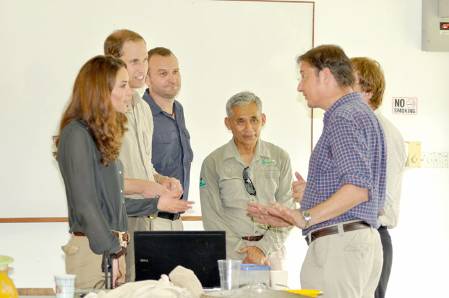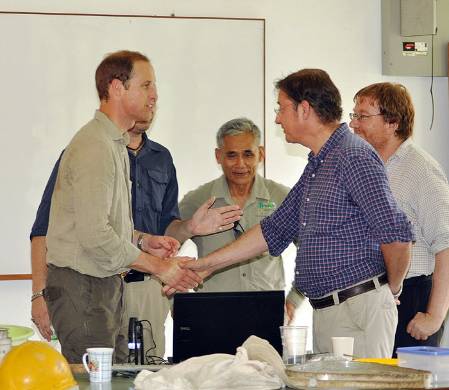Tom is blogging on behalf of Dan Capenter...
We have been in Maliau for just over a week now and we have achieved a lot in that time. As in Danum, we are doing 8 plots in the forest, using each of the six sampling/trapping methods. We have now completed the soil pits, leaf litter samples and dead wood samples in all 8 plots.
A view out over the forest at Maliau
It has been quite hard work at times. Getting to some of the plots is really challenging, trying to follow vague trails and coping with the rugged terrain. It can get very tiring, especially with the heat and humidity to contend with as well. But we have been to some lovely forest and we have managed to get our plots more or less where we wanted them.
The leaves are to keep the sun out of my face for filming – honest!
The sampling has gone really well. We have been getting lots of invertebrates in the soil and dead wood; plenty of termites and ants, plus occasional beetles, woodlice, millipedes and scorpions! The litter sampling seems to be going well too, there are plenty of invertebrates in the samples, but quite what is in there we won’t know until we get the samples home.
The trapping methods have been mixed. The Malaise traps are working very well and collecting hundreds of individuals, mostly flies (Diptera), wasps and beetles, but also moths and a few other things in there as well. The pitfall traps have struggled with the heavy rain in some of the sites, but they too are collecting some great stuff, including the whip scorpion pictured below.
A pitfall trap in the forest
A whip scorpion from a pitfall trap
The only traps that have been a little disappointing are the SLAM traps. They don’t have much in them. It is hard to say why this is. I suspect it is because they are too high to trap all the things that are flying around nearer to the ground, but not high enough to trap the things that are flying around in the canopy proper. This is an interesting result however, as it tells us something about where in the forest most of the activity might be and where it isn’t. Despite the small numbers of invertebrates, they still occasionally trap some interesting things, like a stick insect.
I have really enjoyed working in the forest at Maliau and today we had a real treat. As we were all heading out to our plots this morning gibbons were spotted in the trees as we were crossing the bridge into the forest. We have heard gibbons calling every morning since we arrived in Maliau and sometimes they have been very close without us being able to see them. Today we were lucky though and saw them clearly, swinging through the trees. It was a fantastic sight and definitely a highlight for me.
So we have two more plots to visit to take our traps down, one day to pack up all of our samples and equipment and then we leave Maliau on Friday to start our journey back to the UK. It has been a long trip and I for one am quite tired. It has been hard work, a great experience, and we have done some fantastic science. But I am looking forward to getting home and getting started on sorting and identifying the material we have sampled. That is when the real work begins!
Dan Carpenter





